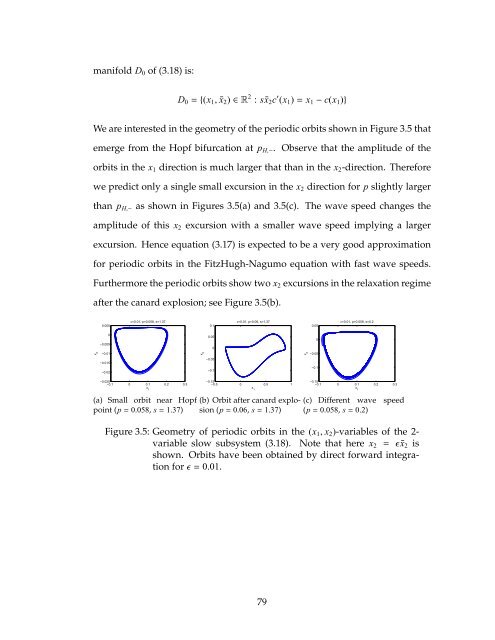multiple time scale dynamics with two fast variables and one slow ...
multiple time scale dynamics with two fast variables and one slow ...
multiple time scale dynamics with two fast variables and one slow ...
Create successful ePaper yourself
Turn your PDF publications into a flip-book with our unique Google optimized e-Paper software.
manifold D0 of (3.18) is:<br />
D0={(x1, ¯x2)∈R 2 : s ¯x2c ′ (x1)= x1− c(x1)}<br />
We are interested in the geometry of the periodic orbits shown in Figure 3.5 that<br />
emerge from the Hopf bifurcation at pH,−. Observe that the amplitude of the<br />
orbits in the x1 direction is much larger that than in the x2-direction. Therefore<br />
we predict only a single small excursion in the x2 direction for p slightly larger<br />
than pH,− as shown in Figures 3.5(a) <strong>and</strong> 3.5(c). The wave speed changes the<br />
amplitude of this x2 excursion <strong>with</strong> a smaller wave speed implying a larger<br />
excursion. Hence equation (3.17) is expected to be a very good approximation<br />
for periodic orbits in the FitzHugh-Nagumo equation <strong>with</strong> <strong>fast</strong> wave speeds.<br />
Furthermore the periodic orbits show <strong>two</strong> x2 excursions in the relaxation regime<br />
after the canard explosion; see Figure 3.5(b).<br />
x 2<br />
0.005<br />
0<br />
−0.005<br />
−0.01<br />
−0.015<br />
−0.02<br />
ε=0.01, p=0.058, s=1.37<br />
−0.025<br />
−0.1 0 0.1<br />
x<br />
1<br />
0.2 0.3<br />
(a) Small orbit near Hopf<br />
point (p=0.058, s=1.37)<br />
x 2<br />
0.1<br />
0.05<br />
0<br />
−0.05<br />
−0.1<br />
ε=0.01, p=0.06, s=1.37<br />
−0.15<br />
−0.5 0 0.5 1<br />
x<br />
1<br />
(b) Orbit after canard explosion<br />
(p=0.06, s=1.37)<br />
x 2<br />
0.05<br />
0<br />
−0.05<br />
−0.1<br />
ε=0.01, p=0.058, s=0.2<br />
−0.15<br />
−0.1 0 0.1<br />
x<br />
1<br />
0.2 0.3<br />
(c) Different wave speed<br />
(p=0.058, s=0.2)<br />
Figure 3.5: Geometry of periodic orbits in the (x1, x2)-<strong>variables</strong> of the 2variable<br />
<strong>slow</strong> subsystem (3.18). Note that here x2 = ǫ ¯x2 is<br />
shown. Orbits have been obtained by direct forward integration<br />
forǫ= 0.01.<br />
79
















